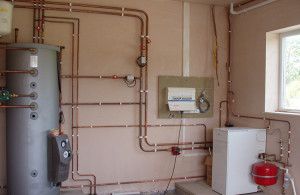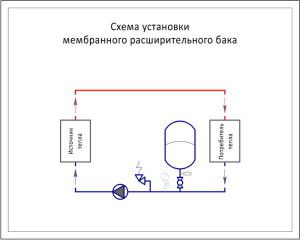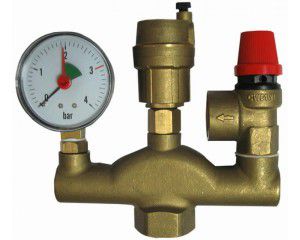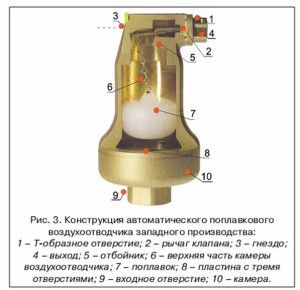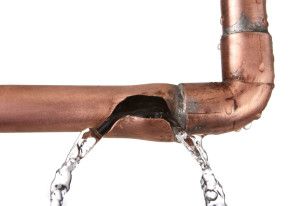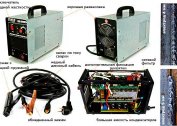For the organization of the heat supply system of a private house or apartment, the most suitable option is a closed heating scheme. It is characterized by a high degree of reliability, efficiency and the ability to control the main parameters. However, to create a professional scheme, you need to know what a closed heating system consists of: expansion tanks, circuits and the required equipment.
Features of designing a closed heating system
The principle of operation of closed heat supply is to create high pressure. This is due to the thermal expansion of hot water or other coolant. At the same time, the pressure in the closed heating system of a private house contributes to better circulation and, as a result, uniform thermal distribution.
Unlike gravity schemes, before installation, you need to learn in detail how a closed heating system works. When the coolant is heated, it expands and increases in pressure, which provoke the onset of circulation.
But this may not be enough. And therefore, a pump is added to the system. It allows you to increase the speed of movement of hot water and thereby reduce the degree of cooling of the coolant in the return pipe. This leads to a decrease in energy consumption.
For the design, you need to know the closed-type water heating device, its minimum equipment. It should consist of the following components:
- A heating element. It can be a boiler of various types - gas, electric, solid fuel. The main condition is work safety and a proper power indicator. A heat exchanger must be installed in its design for connection to a closed-type heating system circuit;
- Pipelines. They provide hot water to radiators and batteries. The determining requirement is the ability to withstand the maximum and operating pressure in a closed-type heating system and temperature exposure;
- Radiators and batteries. With their help, heat is transferred from hot water to indoor air;
- Expansion tank. A key element in the scheme, as it is designed to stabilize the heat supply. If the critical pressure is exceeded, the expansion tank for closed-type heating compensates for it, thereby avoiding the occurrence of emergency situations;
- Security group. It performs the same functions as the expansion tank, but to a fuller extent. Correct installation of the security group in a closed heating system consists in installing an air vent and a bleed valve. It is important to determine the location of these elements in advance.
To ensure control of work and the ability to control the parameters of heat supply, installation of temperature and pressure sensors is required. Additionally, a heating circuit with a closed expansion tank should include the installation of a pressure sensor on the air chamber of the device.
For large areas, a two-pipe closed heating system is recommended. Despite the relatively large initial costs in the future, it will be able to ensure efficient operation of the heat supply.
Closed heating circuits
The first priority in the design of heat supply of a closed type is the choice of the optimal scheme.First of all, this applies to piping and installation of the required components.
It is also necessary that the filling of the coolant into a closed heating system works in automatic mode to ensure safety and stability.
For heat supply of small areas, a closed single-pipe heating system is most often installed. Its scheme includes one pipeline to which radiators are connected in series.
At the same time, the space for installing devices is significantly saved, and the initial costs of acquiring components are reduced.
However, a significant drawback of a closed single-pipe heating system is the small heating area. The maximum length of the trunk can be only 30 m. With an increase in this parameter, a temperature imbalance of the system will be observed.
To increase efficiency and reliability, a two-pipe closed heating system is mounted. In addition to the main highway, a return pipe is provided in it. In this case, radiators are connected in parallel. Those. the basis of the flow of hot water flows through the supply line and enters the radiators through connections with tees.
The defining advantage of this closed-circuit heating system scheme is an increase in the heat supply area.
At the same time, the indicators of the thermal distribution of the rooms in the house do not worsen. But for greater efficiency of the heat supply, it is recommended to install thermostats on the batteries, as well as connect the programmer to the boiler.
The advantages of a two-pipe closed-type water heating device are as follows:
- High maintainability. In case of failure of one of the elements, it is enough to block the access of the coolant in this section. Due to this, the installation of a security group in a closed heating system can be performed even with active heat supply;
- Temperature control in every room. For this, installation of temperature controllers in the binding of heating radiators is necessary;
- Possibility of automatic replenishment of water. For this, a block is needed to fill the coolant into a closed heating system, which is installed on the return pipe. In a closed one-pipe heat supply system, this can lead to thermal shock.
First you need to calculate all the heating parameters. For this, it is best to use specialized programs. Otherwise, the question may arise - where does the air come from in a closed heating system. This is often a phenomenon that is associated with the oxygen content in the coolant, its composition and the temperature regime of the system. To minimize this, it is necessary to install a security group in a closed heating system.
For compact heating, it is recommended to choose schemes for a two-pipe closed heat supply system with horizontal pipe layout. But in this case, the installation of a circulation pump is mandatory.
Expansion tank in a closed heating system
To control the operation of the heating system, devices are needed to ensure its safety. One of them is an expansion tank. It compensates for excess pressure arising from overheating of the coolant. But before its installation, it is necessary to calculate the expansion tank for a closed heating system.
The normal pressure in a closed heating system of a private house should not exceed 4-5 atm. Otherwise, the probability of depressurization of pipes and batteries increases. To stabilize the working pressure in the closed heating system, an expansion tank is required. Structurally, it consists of two chambers - air and water.The first is designed to compensate for the expansion of the coolant, and the second is connected to the heating. In heating circuits with a closed expansion tank, it is provided for its installation on the return line in front of the circulation pump. This is due to the fact that constant hydraulic vibrations resulting from the operation of the pump should not affect the elastic membrane.
One of the advantages of using a closed heating system is the lack of direct contact with air. But to compensate for the expansion of water, reserve space is needed. It is for this task that the installation of an expansion tank for heating a closed type is done. Before this, you should correctly calculate its characteristics.
To calculate the expansion tank for a closed heating system, you need to know the following system parameters:
- The coefficient of thermal expansion of the coolant - E. For water, this value is 0.034 at a temperature of + 85 ° C;
- The total volume of water in the system is WITH;
- Initial pressure - Rnach;
- Maximum pressure - Rmax;
- Fill factor - Kzap.
The last parameter can be found in the table. Often, the question of why pressure drops in a closed heating system arises from the wrong choice of expansion tank.
Suppose that according to preliminary calculations of the heat supply scheme with a closed expansion tank, the values of these parameters correspond to the data from the table.
|
Parameter |
Value |
| The coefficient of thermal expansion of the coolant |
0,034 |
| The total volume of water in the system |
360 |
| Initial pressure |
1,7 |
| Maximum pressure |
4 |
Based on this, we find the optimal fill factor. In our case, it will be equal to 0.5. Further calculation of the expansion tank for heat supply of the closed type is performed according to the formula:
V = ((E * C) / (1- (Rmin / Rmax)))
After calculations, we find the optimal volume of the expansion tank. To stabilize the pressure in a closed heating system of a private house, a model with a volume of 40 liters is required.
Most expansion tanks have a collapsible housing. But for large structures, it is possible to replace the elastic membrane. Such models have a special flange.
Overview of safety groups for indoor heating
The selection of safety elements is a key point in the design of a closed heating system. They must ensure uninterrupted functioning of the heating, as well as prevent the occurrence of dangerous situations.
Knowing the principle of operation as a closed heating system, you can determine that the greatest danger is the excess of working pressure. With high rates of this parameter, the operation of the expansion tank will not be enough. Therefore, the only way out is to remove excess coolant from the system.
This function is performed by the drain valve. When a critical pressure indicator is reached, the rod opens in it, and part of the coolant is drained into the sewer. If the device is improperly configured, its operation can cause a pressure drop in the closed heating system
The next element of heat supply is an air vent. It would seem, where can air come from in a closed heating system? If the level of heating of the coolant exceeds a critical level, water can pass from a liquid to a gaseous state. In this case, air jams are formed, which negatively affect the performance of the system. For their timely removal from the two-pipe closed heat supply system, installation of an air vent is necessary.
To stabilize the working pressure in a closed-type heat supply system, it is necessary to install elements of safety groups in the following parts of the circuit:
- Air vent. It is installed in a standard set of safety groups immediately after the boiler, in the highest part of the system and on all risers;
- Drain valve. Also a member of security groups. Additionally mounted in distribution manifolds and branching systems.
Correct installation of the security group in a closed heat supply system is carried out at the final stage of installation. Only then can the system be tested.
The characteristics of the safety group must be consistent with the calculated values for heating. It is also necessary to check the performance of the components of the group before each heating season.
Problems with closed heating
Knowledge of the closed-type water heat supply device and the correct selection of its components will avoid many problems during the operation of the system. But some of them will arise in any case. Consider the most common deviations in the operation of heating.
Most often, the cause of emergency situations is the excess of the calculated characteristics of the system. There may be several reasons for this - an unidentified security group, violation of the boiler operating mode.
Therefore, before each heating season, you should check the elements of the system, as well as flush it. Otherwise, clogging in pipes and radiators will lead to an artificial decrease in the volume of coolant, and will reduce heat transfer.
Deviations in the operation of the heating system and possible methods of elimination:
- There is air in a closed heating system. This may be due to improper coolant composition. When pouring the coolant into a closed heat supply system, it is recommended to use distilled water, since it does not contain alkalis and metals;
- Constant pressure drop in the system. This may be due to the presence of microcracks in the pipes or radiators. Gradual leakage of the coolant provokes a decrease in pressure, and can also cause the formation of air jams;
- Expansion tank does not work. The reason is membrane wear as a result of strong pressure on it. This occurs if the tank does not have a safety bleed valve for air. For a non-separable design, the only way out is to purchase a new one. In a tank with a mounting flange, you can independently replace the membrane.
For quick emergency response, it is recommended to purchase repair kits. With their help, you can block the gap that appeared in the pipe or radiator, and thereby stabilize the operation of the entire system. In the future, you can replace a damaged heating element.
The video shows an example of the binding of an expansion tank for a closed heating system:
